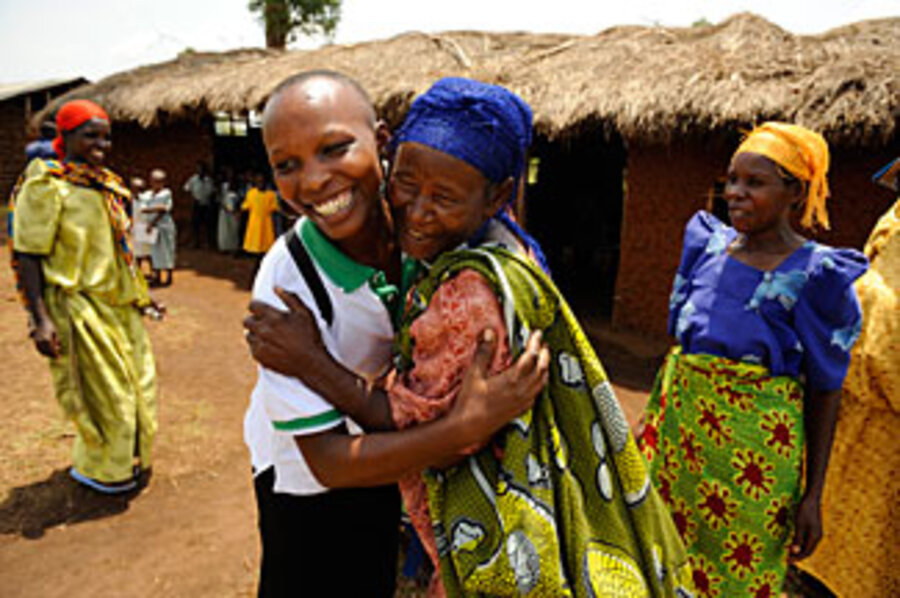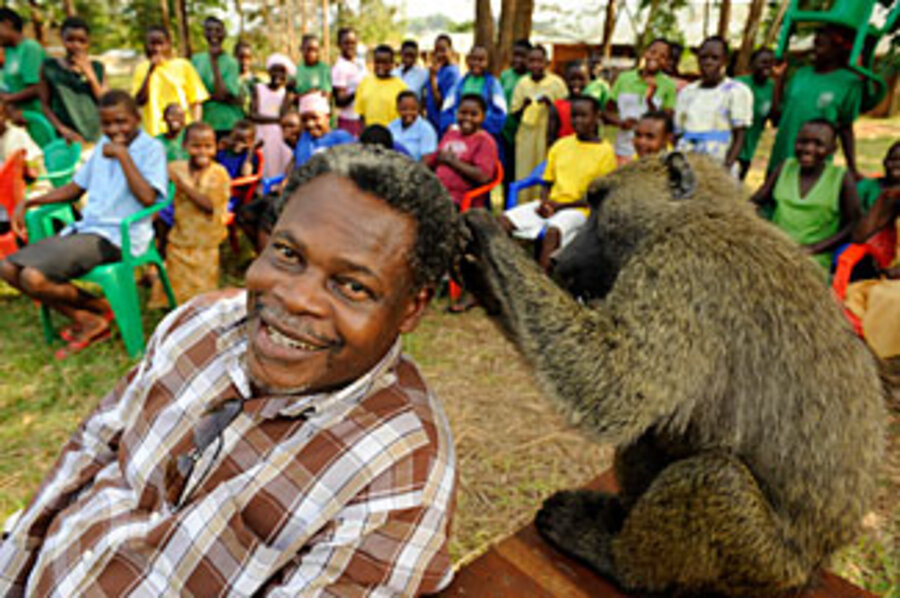African academy empowers youths
| Kagadi, Uganda
Drumbeats pulse through the soft afternoon breeze. Teenage girls sing in unison, ululate, then sing again, cheering on their fellow student-athletes as they play long games of volleyball and netball. Baboons pluck at people's pant cuffs before scampering off to the next bit of mischief.
It's a field day here at the campus of the Uganda Rural Development and Training Programme (URDT), where girls learn how to take hold of their own future, teach their parents key skills, and make "Yes, We Can" more than just a campaign slogan in a faraway land.
These girls might not know it, but their small school is being watched as a potential model for transforming poor, war-torn African nations.
With a median age of 15, Uganda has the world's youngest population, according to a 2008 World Bank report. It also has the highest youth (ages 15 to 24) unemployment rate: 83 percent. It's common to find 20-somethings with law and business degrees stocking supermarket shelves. To break the cycle of poverty and war in places like Uganda, some development specialists now say that people don't need fancy degrees; they need to gain practical skills to create their own income – in the countryside – so they won't flood urban slums or join militias. The answer, they say, also lies in helping people learn how to maximize the assets they already have, and in changing the culture from "hands-out" to "can-do."
"Youth unemployment is the most critical problem Africa faces at the moment," says Calestous Juma, a Kenyan professor of international development at Harvard University in Cambridge, Mass. "If you find something that works in Uganda, it will work elsewhere in Africa."
Mr. Juma stresses that the focus must be on creating jobs in rural areas in order to prevent the overcrowding of cities that is emerging as an enormous problem throughout the developing world. "If you are only confronting youth unemployment in the cities, you have already lost half the battle," he says, adding that rural polytechnic schools like URDT are crucial. "The key thing is skills, skills, skills."
Enter Mwalimu Musheshe. In 1987, the former political prisoner cofounded URDT. The program began as small-scale projects to improve the lives of villagers making less than $1 a day. Now it includes an institute for microentrepreneurs, an educational radio station that reaches more than 2 million people, a school for girls, and a polytechnic university for women.
"The same factors that lead to war are the things communities can [fix] themselves, but they haven't been shown how," says Mr. Musheshe. "We ask people: 'Why don't you have clean water?' They list all these external factors, but they forget to list themselves. We help them understand that they are the No. 1 resource."
It's difficult to feel as though you're a No. 1 resource when your illiterate parents make less than $1 a day. But girls from families who make more than that need not apply to URDT's high school. It's only for the poorest of the poor.
Oprah Winfrey's Leadership Academy for Girls, it's not. Unlike that campus in South Africa, which opened in 2007 with a $40 million donation from Ms. Winfrey, there's no "wellness center," no 200-thread-count sheets or yoga classes.
URDT is decidedly modest by comparison, but not modest in the scope of what it aims to do.
"If you can change [the local district of Kibaale], you can change the whole of Uganda and Africa," Musheshe told the girls during a recent lecture. He sees the work of URDT as part of an "African Renaissance" that begins with rebuilding the "mental infrastructure" so Africans can believe they can achieve whatever they want in life, but only through their own creativity and effort.
As part of URDT's signature "two-generational approach," each student at the high school must help her own family start a project that improves their lives. First, the girls have to sit their parents down to articulate a "vision" for how they want their lives to be and a feasible plan for what they – not anyone else – will do to bring that vision to fruition. Then they have to work together to make it all happen, with guidance and support from the school's staff. They are graded on the results.
In the nearby village of Kabuga – a series of subsistence farms connected by a bumpy mud road and small paths through the lush green crops – URDT high school senior Sanyu Provia tells how she took lessons learned at school to encourage her father to plant sugar cane instead of buying it.
Soon, the family had three large fields of sugar cane that they sold to villagers to boost their income. With the extra cash they built a new, more spacious house and bought a small motorcycle, which allowed her father to open a convenience store in the nearby town.
URDT staff are now helping Ms. Provia and her father boost their sugar-cane yields and teaching him business and bookkeeping skills to maximize earnings – and savings – from the store. More than 260 girls are offering leadership in their own households this way.
URDT also has an open-door policy: Any local villager can come in and ask for training on farming techniques and business skills. Fred Nkunda has taken advantage of this.
Not long ago, Mr. Nkunda had no regular income. Now he's making 500,000 Ugandan shillings (nearly $225) a month from the sprawling fields of pineapples, sesame, chilies, cotton, and vanilla orchids that URDT trainers helped him plant. They taught him how to do a cost-benefit analysis, which helped him determine that there was a solid demand for the pineapples that now account for most of his income. They also taught him leadership skills and how to budget. He now hires a small staff of farmers to tend his crops and is saving up for a machine to produce his own jam and juice.
"I'm passing the skills on to other people," he says, explaining that he's started selling pineapple plants to farmers so that they can plant them on their own land. "If you have a vision, you can mobilize people around your vision."
Without a doubt, 'vision' is Musheshe's favorite word. His eyes light up when he says it.
"We don't start with the problem, we start with vision. Our inner eyes have the ability to picture what we want to see," he says. "We help the person bring the future into the present and say: 'This is what I want.' "
"We need to get out of the straightjacket of traditional thinking," Musheshe says. "At a very early age, we teach kids more don'ts than dos."
This point is personal for Musheshe.
"I grew up curious about issues of change," says Musheshe, who consistently managed to run afoul of boundaries proscribed by authority figures. Teachers at his Anglican school used to write on his report card that he was "too argumentative." That carried into Uganda's Makerere University, where he studied agricultural engineering but spent much of his time agitating with student groups until one day he found himself locked in a jail for challenging the rule of strongman Milton Obote.
He says he was questioned and beaten by soldiers who gave him a large scar in his chin. Once freed, colleagues asked him to join the rebel movement of the current president, Yoweri Museveni. "People wanted me to fight. I said, 'No.' "
It was a pivotal moment: "I recognized that using the gun would take longer than working with communities."
When asked why the school is only for girls, Musheshe quips, "Why not girls?" before explaining: "If you educate a woman, you educate a family. If you educate a man, you only educate an individual."
In Charlotte Mbaime's case, she's educated a village.
Ms. Mbaime graduated in May from URDT's African Rural University (ARU), which opened in 2006. She's part of the first crop of graduates and recently finished her one-month placement in a nearby village.
"The most important thing I learned was that I can't force them to do what they don't want to do," she says. "You can't just come from school and tell them what to do. You have to encourage them to have their own vision."
Before Mbaime finished her month's service in the village, they had pooled enough money to construct a basic building for the school, which has expanded to include a seventh grade. Villagers also worked together to build roads, which aren't yet complete, and to lay the brick foundation for half a dozen houses.
"If people stay committed, it will be a very beautiful village," says Mbaime.
Creating jobs for young people is not a new focus for those who've dedicated their lives to fighting poverty. But it's not easy, either. "There are no magic bullets, no panacea," says Jorge Arbache, an expert in youth employment at the World Bank.
More often than not, Mr. Arbache says, the key to a poor country's development is steady agricultural growth in the countryside. But, he notes, this is one of the least sexy areas for donors.
"The focus needs to be on steady growth, not fast growth. But people don't want to wait for slow growth," he sighs.
He points to Brazil, where 60 to 70 percent of rural jobs there now are in services supporting the country's booming agricultural sector. Had the government not poured money into high-tech agribusiness solutions and helped rural people obtain lines of credit throughout the 1970s and '80s, many more young Brazilians would have flooded the cities.
In addition to recognizing that job creation should focus on practical training in rural areas, more and more experts are helping poor youths maximize what assets they already have, rather than pour in aid money.
David James-Wilson, a leading expert in youth employment at the Education Development Center in Washington, says, "Some organizations think, 'We need to get kids a job.' But kids have three or four informal [jobs] already. The first step is recognizing that young people have assets and aren't just passive."
Financial literacy and training are key, Mr. James-Wilson says. He points to a pilot project in rural Uganda by Save the Children, which is teaching teenagers how to save and invest the money they already have in order to increase their assets.
"When we did the research, we found that kids were asking for knowledge, not money," says Julie Bayiga, a youth program officer with Save the Children-Uganda. "So we asked ourselves: 'How can we build their assets without adding any?' "
Musheshe was onto this approach about 20 years ago. But now he's seeing the fruits of his labor: a university where Africans from all over the continent can learn how to transform rural communities. "When I see 1988 versus now, I feel we made a leap into the future," he says. "We've demonstrated that the methodology works."
Since the late '80s, Kagadi has changed from a two-street trading town to a bustling town with 24 streets, and URDT has been the engine of that growth. According to local government statistics, the population below the poverty line has decreased from 57 percent in 1986 to 31 percent in 2005. Literacy levels have increased from 24 percent to 69 percent. And where apathy once reigned supreme, political participation is up to 80 percent.
There's a long way to go. Most people are still peasant farmers living on less than $2 a day. The nearest paved road is hours away.
"We are doing a hard and complicated thing," says Musheshe. "You must give it time. If it were easy, someone would have done it already."






